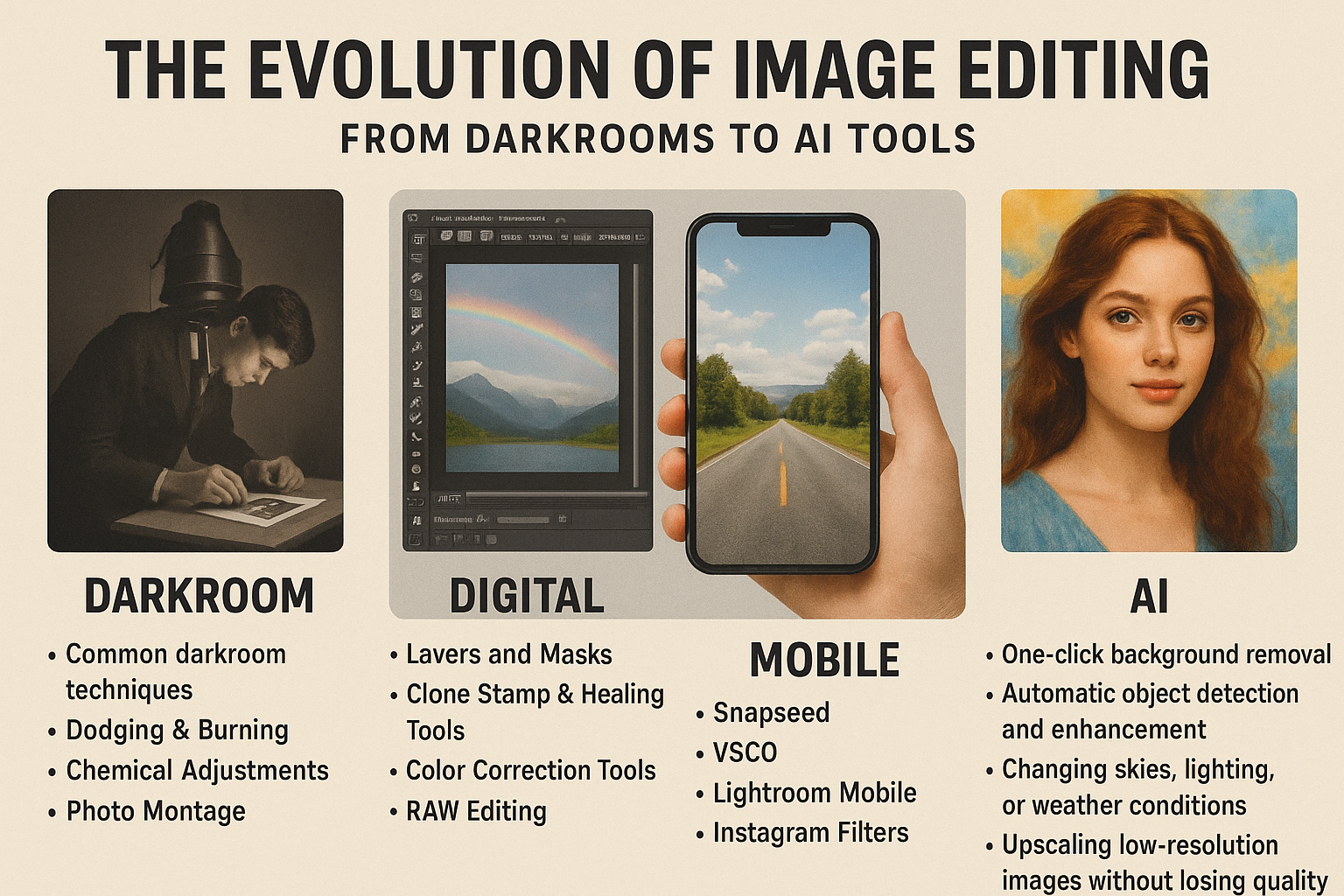
Image editing has come a long way—from chemical-filled darkrooms to sophisticated artificial intelligence tools that can transform photos with a single click. As photography and technology evolved side by side, the way we enhance images has continuously shifted, becoming faster, more accessible, and more creative. Today, AI has revolutionized editing workflows, making advanced capabilities available to everyone—not just professional photographers.
In this blog, we take a journey through the major milestones in the evolution of image editing.
1. The Darkroom Era: Where It All Began
Before digital screens and editing apps, image manipulation started in the darkrooms of film photographers. Here, creativity wasn’t limited to capturing the perfect shot—it extended to how the film was processed.
Common Darkroom Techniques
- Dodging & Burning: Lightening or darkening parts of an image manually.
- Chemical Adjustments: Changing contrast, exposure, and tone using chemical baths.
- Photo Montage: Manually combining negatives for early “composites.”
These techniques required precision, patience, and deep understanding of both chemistry and photography. While time-consuming, they produced some of the most iconic images of the 20th century.
2. The Rise of Digital Editing: Photoshop Changes Everything
The 1990s marked a revolution. With the arrival of digital cameras and Adobe Photoshop, image editing left the darkroom and entered the desktop.
Key Advancements in Digital Editing
- Layers and Masks: Allowing non-destructive editing.
- Clone Stamp & Healing Tools: Making retouching more precise.
- Color Correction Tools: Giving editors full control over tones and hues.
- RAW Editing: Offering high-quality image adjustments.
Suddenly, editing became more flexible—and more powerful. What used to take hours in a darkroom could be done in minutes on a computer.
3. Mobile Editing and Apps: Editing on the Go
As smartphones equipped with cameras became widespread, editing tools followed.
Apps like:
- Snapseed
- VSCO
- Lightroom Mobile
- Instagram Filters
…made professional-like editing available to everyday users. Simple sliders for contrast, saturation, highlights, and shadows turned casual photography into a creative hobby for millions.
4. AI Image Editing: The New Generation
Today, we’re in the era of AI-powered editing, where technology doesn’t just assist — it makes decisions, understands scenes, and performs complex edits automatically.
What AI Image Editing Can Do
- One-click background removal
- Automatic object detection and enhancement
- Changing skies, lighting, or weather conditions
- Upscaling low-resolution images without losing quality
- Portrait retouching using facial recognition
- Colorizing old black-and-white photos
- Generating entirely new images from text prompts
Tools like Adobe Firefly, Midjourney, DALL·E, Canva AI, and many others have reshaped how creators work. Even beginners can perform edits that previously required expert-level skills.
5. Why AI Editing Matters
AI hasn’t replaced creativity—it has amplified it. Instead of spending hours on technical tasks, creators can focus on storytelling and design.
Benefits of AI Editing
- Speed: Edits that took hours now take seconds.
- Accessibility: No advanced training required.
- Consistency: Automated edits maintain uniform quality.
- Innovation: New creative possibilities, from generative art to photorealistic composites.
AI tools are also transforming industries such as marketing, e-commerce, filmmaking, and social media content creation.
6. The Future of Image Editing
As AI models become more powerful, image editing will continue evolving. We can expect:
- Real-time editing during photography.
- Automated visual branding for businesses.
- More advanced 3D and AR/VR image manipulation.
- Hyper-realistic generative visuals that blend photography and imagination.
One thing is certain—the journey from darkrooms to AI has only begun. The next decade will reshape what we consider “editing” altogether.
Final Thoughts
Image editing has transformed from a hands-on chemical process to a digital art form powered by artificial intelligence. Whether you’re a photographer, designer, marketer, or casual smartphone user, today’s tools offer limitless creative potential.
As AI continues to evolve, the future of image editing promises to be faster, smarter, and more imaginative than ever before.


